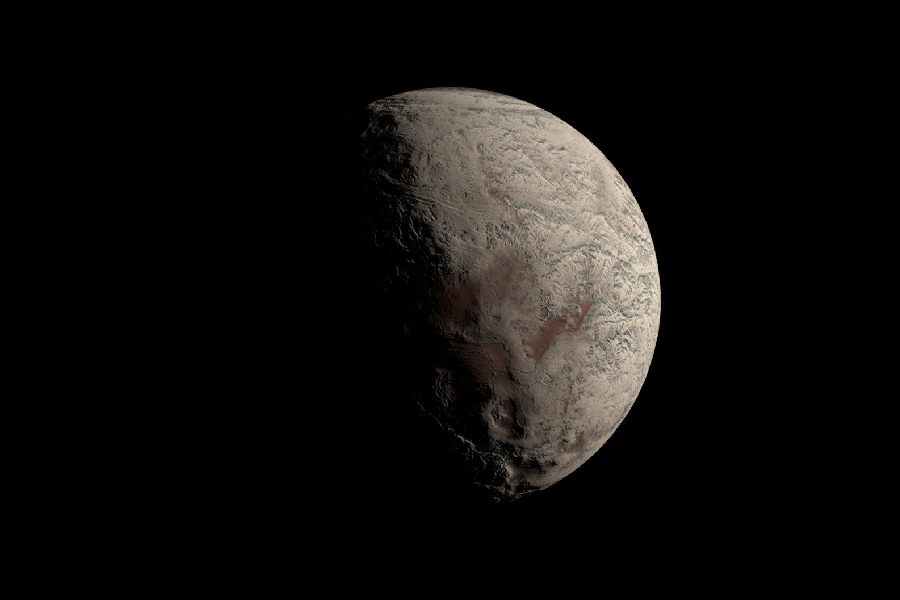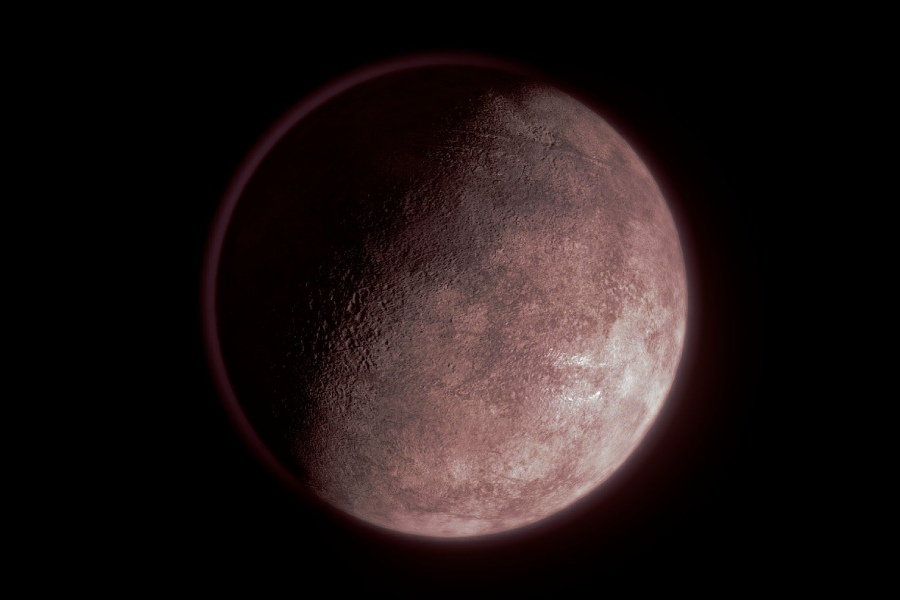Far past Pluto, a reddish world glides through the frigid darkness in a celestial orbit unlike any other. This mysterious planetary body, named Sedna, travels the most distant path around our Sun. Its bizarre, highly elongated orbit carries it three times further than distant Pluto at its farthest point. Yet Sedna’s origins and classification remain shrouded in uncertainty. Is it an inner Oort cloud object, a scattered disc resident, or something else entirely? What is Sedna?
With a size comparable to Pluto’s large moon Charon, this distant denizen teases the boundaries of our solar system definitions. What exactly is this strange world tucked away in the outer darkness? How does Sedna fit into our understanding of the Sun’s family of planets, dwarf planets, and minor bodies?
The continued study of Sedna can offer us unique insights into the far-distant bounds of our stellar vicinity. Below, we explore what Sedna reveals and its perplexing yet fascinating nature. This article uncovers what Sedna tells us and details its complex and intriguing attributes.

What Is Sedna?
What Is Sedna? Sedna is a small, icy object in our Solar System, kind of like a dwarf planet discovered in 2003. What makes Sedna interesting is its weird orbit – it’s really far away and takes a long time to go around the Sun.
Scientists are curious about Sedna because it might help us understand more about how our Solar System formed and if there’s anything else out there influencing its movements. Let’s uncover some more interesting facts about Sedna!
Sedna – Discovery and Naming
Historical background of Sedna’s discovery
In the early 2000s, advances in telescopes enabled observing more distant solar system objects. Mike Brown, Chad Trujillo, and David Rabinowitz conducted surveys searching for these dim outer bodies. On November 14, 2003, they discovered Sedna using the Palomar Observatory. Its extreme orbit was unique.
Discovery process and key astronomers involved
The team discovered Sedna by taking multiple images of a region over months to detect objects moving against background stars. They used the Samuel Oschin Telescope and a mosaic CCD camera. The discovery extended the known solar system and sparked new questions about distant minor planets.
Naming conventions and mythology associated with Sedna
The team chose the name Sedna after an Inuit goddess associated with the sea and marine animals. This followed a tradition of naming trans-Neptunian objects after creation deities.
Sedna’s distant, cold home paralleled the goddess narrative. The name fits this unique new resident of the outer solar system. Now that it’s clear who discovered Sedna, let’s dive deeper to understand what cosmic play led to its creation in the Solar System.
Origin and Formation
Theoretical models explaining Sedna’s formation
The leading idea is Sedna formed closer in and was perturbed outward. One model proposes Sedna was tugged by a passing star early in the Solar System’s history.
Others suggest gravitational nudging by a large trans-Neptunian planet. Contrasting theories hypothesize in situ formation in the outer solar nebula.
Hypotheses about Sedna’s migration and distant orbit
Most evidence supports outward migration from the inner Oort cloud or scattered disk. Sedna’s highly elliptical orbit doesn’t match the Kuiper belt.
A close stellar encounter or unseen planet gravity likely drove Sedna outward long ago. Understanding Sedna’s orbit offers clues to the Solar System’s dynamic history.
Contributions to our understanding of the early Solar System
Studying Sedna provides insights into processes in the early Solar System. Its surface retains primordial compounds from the solar nebula.
Comparison to other icy bodies constrains its formation location. Sedna illustrates how gravitational interactions shaped outer Solar System architecture over time.
Physical Characteristics
Size, mass, and density of Sedna
Sedna has a diameter of roughly 1,000 kilometers. Calculations show a mass of 1.7-6.1×1021 kilograms. And a density of about 2.0? g per cubic centimeter.
Sedna is relatively large compared to other Kuiper Belt objects. It is smaller than Pluto. But larger than most other objects beyond Neptune. Its density is similar to many icy bodies.
Composition and surface features
Observations suggest Sedna is probably two-thirds rock and one-third ice. Spectroscopy shows methane, nitrogen, and organics like tholins.
Little is known of Sedna’s surface features due to its distance. Early observations detected a moderately red color. This indicates organic compounds. Future study is needed for distinct surface markings.
Notable properties distinguishing Sedna from other celestial bodies
Sedna has one of the most elongated orbits in the Solar System. Taking over 11,000 years to orbit the Sun.
Sedna’s unusual orbit raises questions about unseen forces. Perhaps from a distant planet, shaping the outer Solar System. Understanding Sedna can provide insight into the early formation and evolution of structures beyond Neptune.
Being one of the most distant objects in the Solar System, Sedna temperature never exceeds -240°C (-400°F). It is one of the coldest planets as it lies beyond our Sun’s influence.

Orbit and Location
Orbital parameters of Sedna
Sedna has a highly elliptical orbit. Its distance from the Sun ranges from about 76 AU at perihelion to 928 AU at aphelion. Sedna’s orbital period is about 11,400 years. This is an extremely long period compared to most Solar System objects.
Sedna has one of the most eccentric and distant orbits of any known Solar System object aside from long-period comets. Its perihelion is similar to scattered disk objects. But its aphelion reaches much further into distant regions.
Eccentricity and inclination of Sedna’s orbit
Sedna’s orbit has an eccentricity of about 0.85. This means its orbit is highly elongated instead of circular. Sedna’s orbital inclination is about 12 degrees. This tilt exposes Sedna to a range of gravitational pulls over its orbit.
The extreme eccentricity and inclination suggest that Sedna was likely pulled into its unusual orbit by an unseen massive object. This lends support to the hypothetical Planet Nine theory that could explain Sedna’s distant orbit.
Sedna’s position in the Kuiper Belt or the scattered disk
Some astronomers consider Sedna to be part of the inner Oort Cloud instead of the Kuiper Belt or scattered disk due to its distance. But Sedna is too close and lacks the cometary traits of most Oort Cloud objects.
Though isolated, Sedna’s origin means it likely formed among Kuiper Belt objects and interactions with other Solar System bodies placed it onto its eccentric, distant orbit. Future discoveries may link Sedna with additional distant objects.
Unique Characteristics
Unusual orbital characteristics compared to other trans-Neptunian objects
Sedna has an extremely eccentric orbit. As mentioned, its orbital period of 11,400 years is unusually long. Sedna reaches a distance of nearly 1,000 AU from the Sun. This is much farther than most Kuiper Belt or scattered disk objects.
Sedna’s odd orbit sets it apart as perhaps the first observed inner Oort Cloud object. Analyzing Sedna provides evidence for the hypothetical Planet Nine and clues to forces shaping the distant Solar System.
Long orbital period and distance from the Sun
Sedna’s elliptical orbit takes thousands of years to complete. This results from the great distance Sedna reaches from the Sun, along with gravitational tugs from other bodies that impact its path.
Sedna’s orbital distance supports the idea that it is a member of the inner Oort Cloud. Its orbital period means observing its full orbit is challenging. More discoveries like Sedna would strengthen our understanding of the distant Solar System.
Exotic features that make Sedna intriguing for astronomers
Sedna’s size, brightness, and elongated orbit set it apart from expected Kuiper Belt discoveries. Its potential to help clarify outer Solar System outliers generates great interest. But it also raised questions like, ‘Is Sedna a planet’?
Considering how far is Sedna from the sun, early attempts to answer this met many new challenges for our astronomers. Even to answer how big is Sedna was not an easy job after its discovery.
Observations and Studies
Ground-based and space-based observations of Sedna
Sedna was discovered in 2003 by ground-based optical and photographic surveys. Further observations have utilized ground-based telescopes with advanced optics and sensors. Space telescopes like Hubble and Spitzer have also observed Sedna.
Imaging and spectral studies have uncovered Sedna’s diameter, color, orbital parameters, rotational period, and basic composition. Studies indicate Sedna is moderately red, methane-rich, and composed largely of rock and ice.
Telescopes and instruments used for studying this distant object
Sedna detection relied on wide-field survey telescopes, including Palomar Observatory and Cerro Tololo Inter-American Observatory. The study involves 6-10 meter optical/infrared telescopes with tracking cameras and spectrographs.
Improved telescope tracking, adaptive optics, light detection equipment, and lens coatings enable more precise and sensitive Sedna observation over time. Further advancements in telescopes and space observatories will improve the understanding of this celestial object.
Data collection and analysis contributing to our knowledge of Sedna
Spectroscopy reveals composition ties between Sedna and other distant icy bodies. Tracking indicates a distant eccentric orbit. Data helps support the Planet Nine hypothesis and Oort Cloud structure models.
Continued observation aimed at refining Sedna’s orbit, mass, and surface traits. Comparative planetology helps tie Sedna formation models to other Kuiper Belt bodies. The search continues for additional inner Oort Cloud objects.
Conclusion
As we have explored in detail, Sedna is a mysterious dwarf planet candidate far out in the most distant regions of our Solar System. Its bizarre, highly eccentric orbit sets it apart from other known trans-Neptunian objects and points to gravitational forces.
We have yet to fully account for it. We hope this article has helped you better understand what is Sedna – an icy dwarf planet-sized body with properties distinct even among the many intriguing denizens of the Kuiper Belt and inner Oort Cloud.
By analyzing the origins, physical attributes, orbital parameters, and previous observations around this exceptional celestial body, you now have gained broader insight into the true character of Sedna and outer Solar System architecture.
